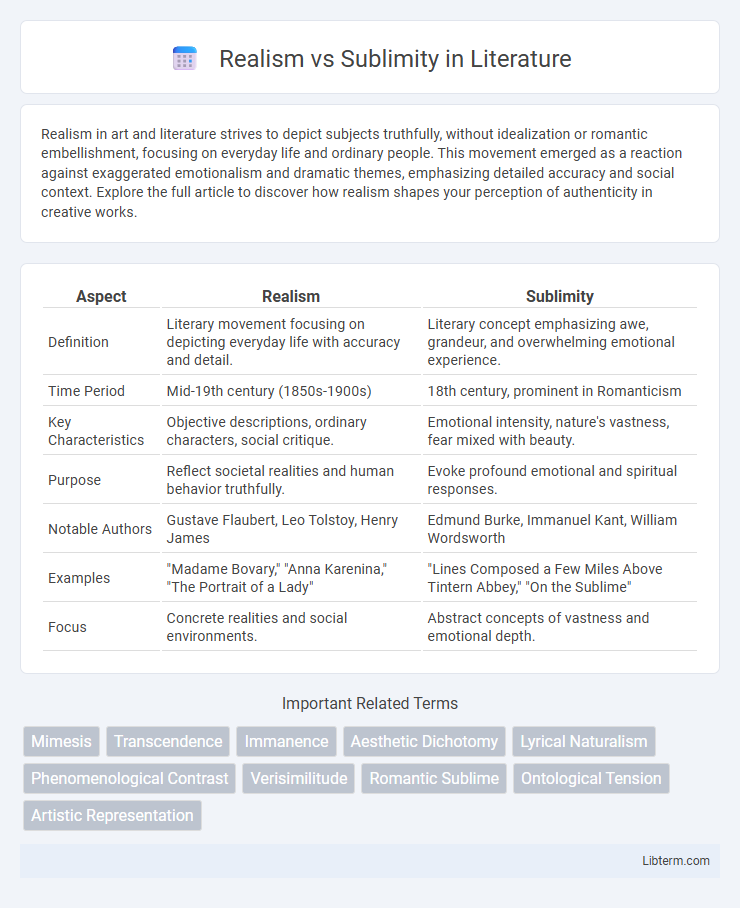Realism in art and literature strives to depict subjects truthfully, without idealization or romantic embellishment, focusing on everyday life and ordinary people. This movement emerged as a reaction against exaggerated emotionalism and dramatic themes, emphasizing detailed accuracy and social context. Explore the full article to discover how realism shapes your perception of authenticity in creative works.
Table of Comparison
| Aspect | Realism | Sublimity |
|---|---|---|
| Definition | Literary movement focusing on depicting everyday life with accuracy and detail. | Literary concept emphasizing awe, grandeur, and overwhelming emotional experience. |
| Time Period | Mid-19th century (1850s-1900s) | 18th century, prominent in Romanticism |
| Key Characteristics | Objective descriptions, ordinary characters, social critique. | Emotional intensity, nature's vastness, fear mixed with beauty. |
| Purpose | Reflect societal realities and human behavior truthfully. | Evoke profound emotional and spiritual responses. |
| Notable Authors | Gustave Flaubert, Leo Tolstoy, Henry James | Edmund Burke, Immanuel Kant, William Wordsworth |
| Examples | "Madame Bovary," "Anna Karenina," "The Portrait of a Lady" | "Lines Composed a Few Miles Above Tintern Abbey," "On the Sublime" |
| Focus | Concrete realities and social environments. | Abstract concepts of vastness and emotional depth. |
Understanding Realism: Definition and Key Concepts
Realism is an artistic and literary movement that emphasizes accurate, detailed, and unembellished depiction of nature or contemporary life, focusing on everyday subjects and ordinary people. Key concepts include objectivity, truthfulness, and the rejection of idealization, aiming to portray the world as it is rather than as it should be. This approach contrasts sharply with sublimity, which seeks to evoke awe and transcendence through grandeur and emotional intensity.
Unpacking Sublimity: Origins and Philosophical Roots
Sublimity traces its origins to 18th-century philosophical discourse, notably in the works of Edmund Burke and Immanuel Kant, who explored the overwhelming emotional response elicited by vast, powerful, or infinite phenomena. Unlike Realism's commitment to depicting the world with precise accuracy and objective representation, Sublimity emphasizes the subjective experience of awe, terror, and grandeur that transcends ordinary perceptions. The philosophical roots of Sublimity highlight a dynamic interplay between human cognition and the natural or metaphysical realms, where the sublime experience challenges rational understanding and evokes profound existential reflection.
Historical Evolution: Realism and Sublimity Across Eras
Realism emerged prominently in the 19th century as a reaction to Romanticism, emphasizing accurate, unembellished depictions of everyday life and society, with notable figures like Gustave Courbet and Honore de Balzac advancing its principles. Sublimity, rooted in 18th-century aesthetics, particularly through Edmund Burke's and Immanuel Kant's philosophies, underscored overwhelming emotional experiences conveyed by nature's vastness or human creativity beyond ordinary comprehension. The historical evolution reveals a tension where realism sought objective truth and social critique, while sublimity pursued transcendental awe and emotional intensity, shaping diverse artistic and literary expressions across modern eras.
Realism in Art and Literature: Hallmarks and Impact
Realism in art and literature emphasizes accurate, detailed, and unembellished depictions of everyday life, focusing on ordinary characters and mundane settings to reflect social realities. Hallmarks include objective observation, complex moral situations, and vernacular language, which challenge romanticized or idealized portrayals. The impact of realism reshaped narrative structures, influenced social consciousness, and laid the groundwork for modern literary and artistic movements by prioritizing authenticity and societal critique.
Sublimity in Art and Literature: Expressions and Influence
Sublimity in art and literature manifests through evocative imagery and themes that inspire awe and profound emotional responses, often transcending everyday experiences. It is characterized by the depiction of grandeur, vastness, and intense emotional depth, influencing movements such as Romanticism and Modernism to explore human perception and the sublime nature of existence. This concept shapes artistic expression by prioritizing transcendent beauty and the confrontation with the infinite, contrasting sharply with the grounded, detailed representation typical of Realism.
Key Differences Between Realism and Sublimity
Realism prioritizes accurate, detailed representation of everyday life and tangible experiences, emphasizing objectivity and concrete details. Sublimity evokes intense emotions through grandeur and awe-inspiring elements, often transcending ordinary perceptions with a focus on the infinite or the extraordinary. The key difference lies in realism's grounded depiction of reality versus sublimity's aim to inspire profound emotional or spiritual responses beyond ordinary experience.
Realism vs Sublimity: Philosophical Debates
Philosophical debates on Realism versus Sublimity center on contrasting views of aesthetic and metaphysical reality, where Realism emphasizes the objective existence and accurate representation of the world, while Sublimity captures the overwhelming, transcendent experience that surpasses ordinary perception. Realists argue that art and knowledge should reflect tangible and verifiable phenomena, whereas proponents of Sublimity assert that true understanding emerges through encounters with the infinite, the vast, or the awe-inspiring, which challenge rational comprehension. This dialectic explores the tension between empirical accuracy and extraordinary emotional or spiritual elevation in human experience and artistic expression.
Cultural and Social Implications of Both Approaches
Realism emphasizes unembellished depictions of everyday life, reflecting social conditions and fostering critical awareness of cultural norms and inequalities. Sublimity captures awe-inspiring moments beyond ordinary experience, often evoking emotional transcendence and influencing cultural ideals of beauty and spirituality. Both approaches shape societal values, with realism promoting empathy and social reform, while sublimity reinforces collective identity and existential meaning.
Modern Interpretations: Blending Realism and Sublimity
Modern interpretations blend realism and sublimity by merging detailed, lifelike depictions with heightened emotional or awe-inspiring elements to evoke profound viewer responses. Artists incorporate precise visual accuracy alongside dramatic contrasts, vast scale, or sublime themes to challenge perceptions and deepen engagement. This fusion enhances narrative depth, making artworks resonate both intellectually and emotionally in contemporary contexts.
Conclusion: Relevance of Realism and Sublimity Today
Realism remains essential for accurately depicting everyday life and fostering critical awareness in contemporary society, while sublimity evokes profound emotional responses and inspires creativity by transcending ordinary experiences. Both concepts complement each other in art and literature, balancing factual representation with heightened emotional depth. Their continued relevance lies in addressing complex human experiences through a blend of truthful depiction and awe-inspiring expression.
Realism Infographic

 libterm.com
libterm.com